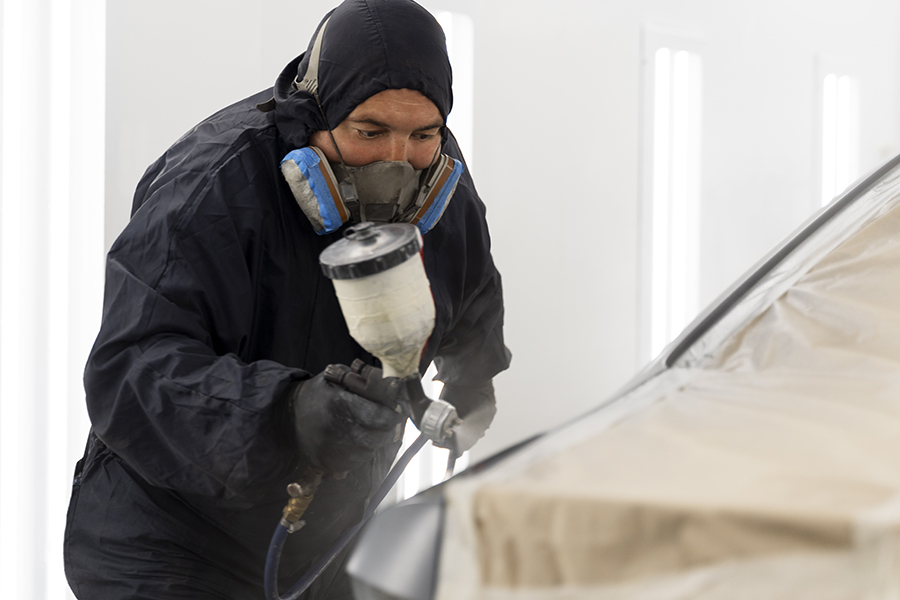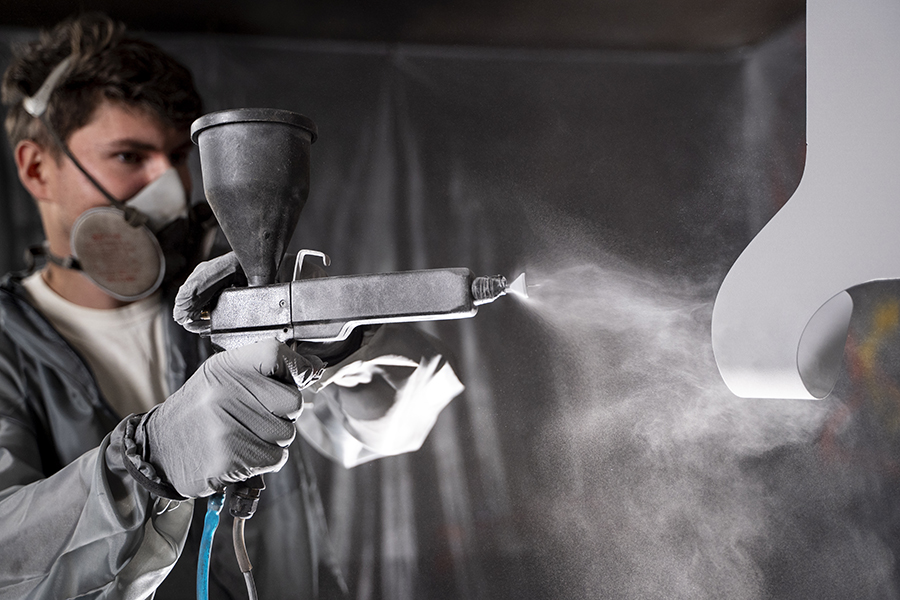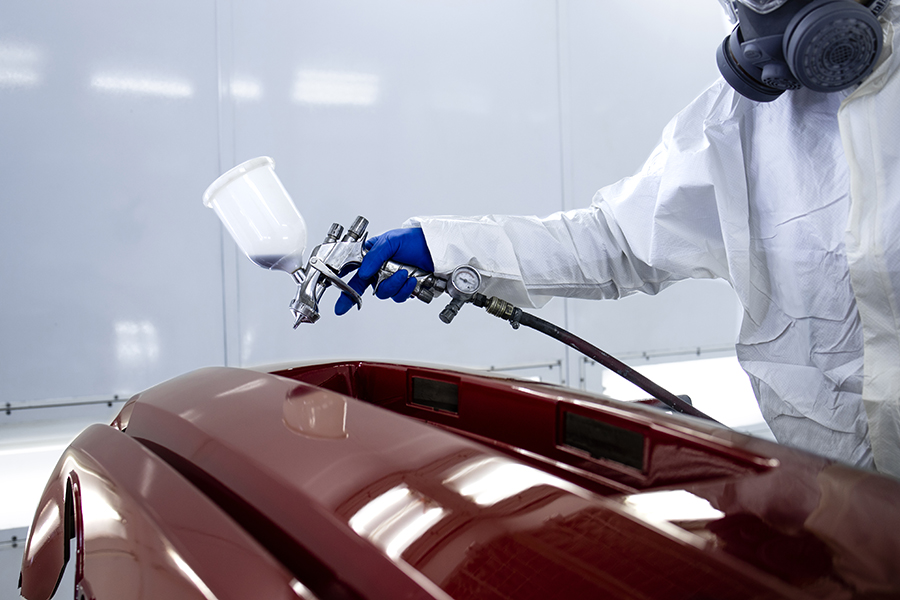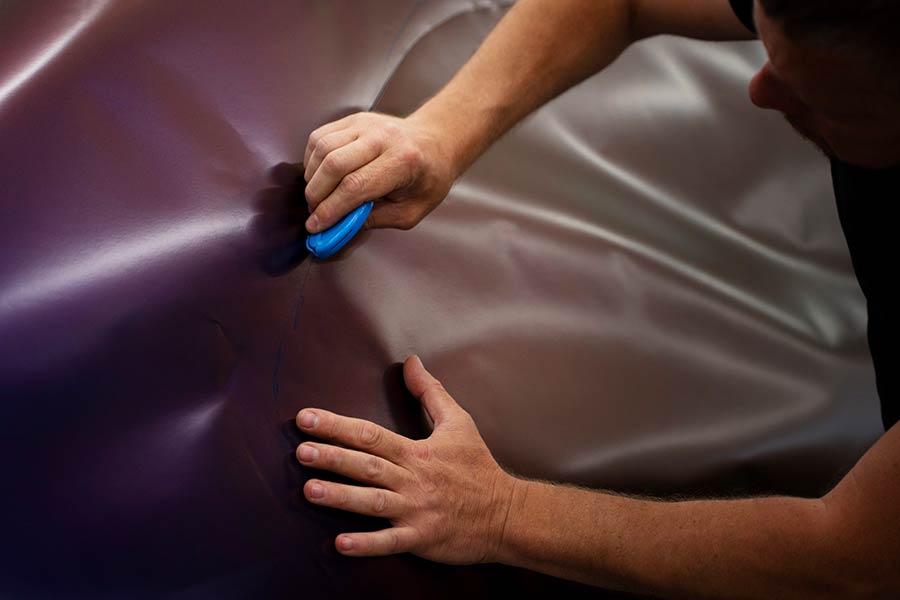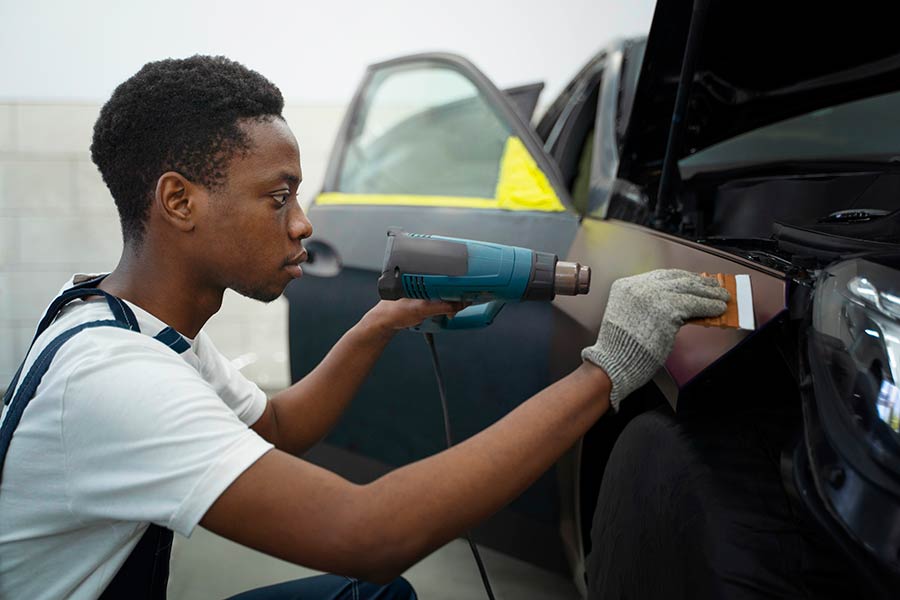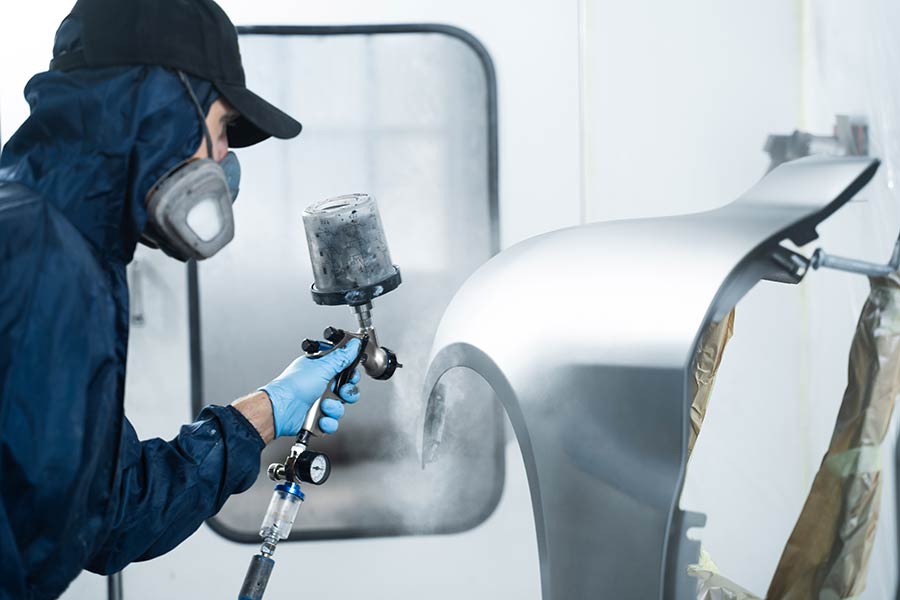Did you know that the average car’s paint job endures over 2,000 minor impacts each year?
From shopping cart dings to harsh weather conditions, your vehicle’s paint faces constant threats. Even a small scratch can lead to rust, reducing both your car’s appearance and value.
We understand how frustrating it feels to see your car’s once-perfect finish marred by scratches, chips, or fading. That’s why professional auto repair paint services make such a difference. Using advanced color-matching technology and precise application techniques, we restore vehicles to their original glory.
In this guide, we’ll walk you through everything you need to know about professional paint repair services, from understanding different types of damage to choosing the right protection solutions for your vehicle. Let’s restore your car’s shine together!
Types of Auto Paint Damage
We see various types of paint damage in our auto repair paint shop every day. Understanding these different forms of damage helps us provide the most effective solutions for your vehicle.
Impact and Collision Damage
Road debris and accidents create immediate visible damage to your car’s paint. Small stones and gravel kicked up while driving lead to chips and scratches that penetrate through paint layers. These damages often start small but can grow worse if left untreated. Deep scratches can reach the metal beneath, creating entry points for rust and corrosion.
Environmental Paint Deterioration
Nature poses constant threats to your car’s paint finish. Here are the main environmental factors we commonly address:
- Hard water deposits from rain or improper washing
- Tree sap that bonds to the paint surface
- Bird droppings containing harmful acids
- Industrial fallout and airborne pollutants
- Mineral deposits that create water spots
- Road salt and de-icing chemicals
Chemical and UV Exposure Effects
The sun’s UV rays break down paint at a molecular level, causing oxidation and fading. We regularly work with vehicles showing signs of UV damage, including cloudy appearances and loss of color vibrancy. Chemical exposure adds another layer of complexity - substances like gasoline, brake fluid, and cleaning agents strip away protective clear coats.
The combination of these factors makes paint particularly vulnerable. When acidic substances like bird droppings or tree sap sit on UV-damaged paint, they create more severe deterioration. That’s why we recommend addressing any paint damage promptly through professional auto repair paint services.
Professional Paint Repair Methods
At our professional auto repair paint facility, we take pride in restoring your vehicle’s finish to its original glory. Let me walk you through our advanced repair methods that make this possible.
Spot Repair Techniques
When dealing with minor damages, we apply targeted spot repair techniques. This method focuses on the damaged area while maintaining the original paint’s integrity. Our process involves:
- Precise damage assessment
- Careful surface preparation
- Graduated sanding techniques
- Color-matched paint application
- Professional finishing touches
Paint Blending Procedures
Paint blending is an art that demands both skill and precision. We divide panels into thirds and blend new paint into existing areas for a seamless finish. For metallic colors, we extend the blend into adjacent panels, while solid colors often allow us to work within the damaged panel.
The success of paint blending relies on proper preparation. We start by wet-sanding with fine-grit paper, moving in a single direction. This creates the perfect foundation for new paint application. Our team applies color in gradual layers, extending each coat slightly beyond the previous one.
Clear Coat Application
The clear coat is more than just a finishing touch - it’s your paint’s shield against environmental damage. We apply it in multiple stages:
First, we prepare the surface meticulously, removing any dust or contaminants. Next comes the initial clear coat layer, applied at precisely 6-8 inches from the surface. After allowing proper flash time between coats, we apply additional layers for maximum durability.
Temperature control plays a crucial role in this process. We maintain optimal conditions in our spray area to achieve the right viscosity for proper adhesion. This attention to detail prevents common issues like orange peel texture or uneven application.
By following these professional methods, we transform damaged surfaces into flawless finishes. Each repair receives the same level of attention, whether it’s a small door ding or extensive panel damage.
Paint Matching Technology
Modern paint matching technology has transformed how we restore your vehicle’s appearance. Our advanced systems make perfect color matches possible, even for the most complex finishes.
Digital Color Matching Systems
We work with state-of-the-art spectrophotometers that read your car’s paint with incredible accuracy. These tools measure light reflection and exact hues on your vehicle’s current finish. By analyzing these measurements, we create a digital profile of your paint’s color properties, including its basic shade and special effects.
The system connects to our paint database, where we store thousands of color formulas. This technology helps us mix paint that matches your car perfectly, whether it’s a standard finish or a complex metallic coating.
Factory Paint Code Analysis
Finding your vehicle’s original paint code is our first step toward a perfect match. These codes are typically located in:
- Driver’s door jamb or frame
- Under the hood (firewall or radiator support)
- Trunk area (often near the spare tire)
- Glove compartment (common in some models)
Each manufacturer uses specific code formats - for instance, Chrysler uses three-digit codes starting with “P,” while Ford employs two letters or a letter-number combination. We analyze these codes against manufacturer databases to find the exact original color formula.
Custom Mix Verification
After creating your paint match, we don’t just mix and apply. Our verification process includes:
- Test panel application to check color accuracy
- Multiple lighting condition assessments
- Digital analysis of the mixed paint
- Side-by-side comparison with your vehicle
We account for paint age and sun exposure, which can affect color appearance. Our mixing system adjusts formulas to match your car’s current condition, not just its factory shade. This attention to detail means the repaired area blends seamlessly with existing paint.
Quality Control Standards
Quality control is the backbone of our auto repair paint services. Through rigorous testing and verification, we maintain the highest standards in the industry.
Paint Thickness Testing
We use advanced electronic paint thickness gages to measure each layer precisely. Factory standard paint typically ranges between 4-7 mils (100-180 microns). Our testing reveals:
- Original paint thickness
- Previous repair work
- Potential weak spots
- Clear coat depth
This data helps us determine the right approach for your vehicle’s paint repair. When readings show thinner areas, we adjust our techniques to protect your car’s finish.
Color Match Verification
Our color match testing goes beyond basic visual inspection. We check your paint under multiple light conditions:
- Natural sunlight
- LED inspection lights
- Full-spectrum lighting
- Various angles and distances
This thorough process helps us spot even minor variations in color, making sure your repair blends perfectly with the existing finish.
Surface Finish Inspection
We perform detailed surface inspections at every stage of the paint process. Our inspection includes:
| Inspection Point | What We Look For |
|---|---|
| Paint Coverage | Even application and hiding |
| Surface Texture | Smooth, consistent finish |
| Gloss Level | Proper shine and reflection |
| Paint Adhesion | Strong bond to surface |
We look at the surface from different distances - close up for fine details and further back for overall appearance. This multi-step inspection process helps us catch and fix any imperfections before they become noticeable issues.
When inspecting clear coat application, we pay special attention to thickness consistency. Too little clear coat won’t protect the paint properly, while too much can lead to running or sagging. Through careful measurement and inspection, we maintain the perfect balance.
Our paint thickness monitoring continues throughout the entire process. We track how much material we remove during preparation and how much we apply during painting. This careful attention to detail results in a finish that not only looks beautiful but also provides lasting protection for your vehicle.
Paint Protection Solutions
After protecting your vehicle with our expert auto repair paint services, we recommend implementing strong protection solutions to maintain that perfect finish. Let me share our most effective paint protection options.
Ceramic Coating Benefits
Our nano-ceramic coating creates a glass-like protective layer that bonds with your car’s paint at a molecular level. This advanced solution offers remarkable benefits:
- Intense water repellency that keeps your car cleaner
- Strong resistance to UV rays and oxidation
- Protection against chemical stains and etching
- Superior gloss and depth that lasts for years
- Reduced need for frequent washing and maintenance
When we apply ceramic coating, it fills the microscopic imperfections in your paint, creating a smooth, flat surface that’s incredibly resistant to contamination.
Paint Protection Films
We offer premium paint protection film (PPF) that acts as a transparent shield for your vehicle’s paint. This thermoplastic urethane material brings remarkable defensive capabilities to your car’s finish.
| Feature | Benefit |
|---|---|
| Self-healing | Minor scratches disappear with heat exposure |
| Impact resistance | Guards against rock chips and road debris |
| UV protection | Prevents paint oxidation and fading |
| Longevity | Lasts 5-10 years with proper care |
The film’s self-healing properties are particularly impressive - when exposed to heat, the elastomeric polymers automatically repair small scratches and swirl marks.
Maintenance Guidelines
Taking care of your paint protection investment is straightforward but crucial. Here’s what we recommend:
-
Regular Cleaning * Use pH-neutral car shampoo * Clean with soft microfiber materials * Remove contaminants promptly * Avoid automatic car washes
-
Periodic Inspections * Check for any damage monthly * Look for edge lifting on PPF * Monitor ceramic coating performance * Schedule professional assessments
For ceramic-coated vehicles, we suggest using special ceramic maintenance sprays every few months. If you’ve chosen PPF, avoid high-pressure washing near the edges, as this can affect adhesion.
Both solutions work exceptionally well together - we often apply ceramic coating over PPF for maximum protection. This combination provides outstanding defense against all the paint damage types we discussed earlier, while maintaining your vehicle’s showroom shine.
Conclusion
Professional auto paint repair stands as a crucial service for maintaining your vehicle’s value and appearance. Paint damage comes from many sources - road debris, environmental factors, and chemical exposure all pose significant threats to your car’s finish.
Our advanced paint matching technology, combined with precise repair methods, brings damaged vehicles back to their original beauty. Through rigorous quality control standards and detailed surface inspections, we deliver results that meet factory specifications.
Paint protection remains vital after repairs. Modern solutions like ceramic coatings and protection films offer outstanding defense against future damage. Right now is the perfect time to schedule repair services for your vehicle and protect your investment.
Regular maintenance and prompt attention to paint issues help preserve your car’s finish for years. Following our recommended care guidelines and choosing professional services makes a real difference in your vehicle’s long-term condition and resale value.
Remember, quality paint repair involves more than just matching colors - it requires expertise, advanced technology, and attention to detail. Schedule repair services today and give your car the professional care it deserves.
## FAQs
-
How much does professional auto paint repair typically cost? The cost of professional auto paint repair can vary widely depending on the extent of the damage, the type of paint used, and the specific repair methods required. Minor touch-ups might cost a few hundred dollars, while a full vehicle repaint can range from $1,000 to $5,000 or more. It’s best to get a personalized quote from a reputable auto body shop for an accurate estimate.
-
How long does a professional auto paint job usually take? The duration of a professional auto paint job depends on the scope of work. Simple spot repairs might be completed in a day or two, while a full vehicle repaint can take a week or more. Factors like the number of coats required, drying time, and any necessary bodywork can affect the overall timeline.
-
Can I paint my car myself instead of using a professional service? While it’s possible to paint a car yourself, achieving professional-quality results is challenging without proper equipment and expertise. DIY paint jobs often lack the durability, color match accuracy, and finish quality of professional work. For best results and to protect your vehicle’s value, it’s recommended to use expert auto repair paint services.
-
How long does a professional auto paint job last? A high-quality professional auto paint job can last for many years with proper care. Factors like environmental conditions, storage, and maintenance affect longevity. With regular cleaning and the application of protective measures like ceramic coatings or paint protection films, a professional paint job can maintain its quality for 10-15 years or more.
-
What’s the difference between ceramic coating and paint protection film? Ceramic coating is a liquid polymer that bonds with the paint surface, providing a hard, glossy protective layer against UV rays, chemical stains, and minor scratches. Paint protection film (PPF) is a clear, thermoplastic urethane film applied to the paint surface, offering stronger protection against rock chips, debris impacts, and has self-healing properties for minor scratches. Both can be used together for maximum protection.
-
How do I maintain my car’s paint after a professional repair or repaint? To maintain your car’s paint after professional work: - Wash regularly with pH-neutral car shampoo and soft microfiber materials - Avoid automatic car washes - Remove contaminants promptly - Apply wax or sealant periodically - Park in covered areas when possible to minimize sun and environmental exposure - Consider professional detailing services annually - Follow specific care instructions for ceramic coatings or paint protection films if applied
-
Can professional paint repair fix rust damage? Professional paint repair services can address rust damage, but the process is more involved than simple paint touch-ups. It typically requires removing the rust, treating the affected area, applying body filler if necessary, priming, and then painting. The effectiveness depends on the extent of rust damage. Early-stage surface rust can often be fully repaired, while extensive structural rust may require panel replacement.
-
How accurate is color matching in professional auto paint repair? Modern professional auto paint repair services use advanced digital color matching systems and spectrophotometers to achieve highly accurate color matches. These technologies analyze the exact hue, metallic content, and effects of your car’s current paint, allowing for precise custom mixing. Professional shops also verify matches under various lighting conditions to ensure seamless blending with existing paint.
